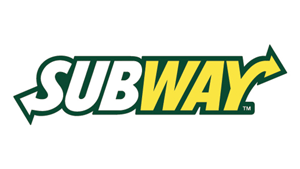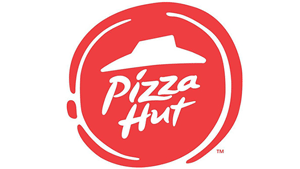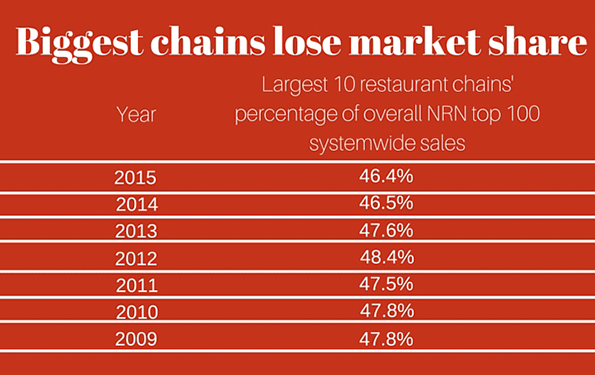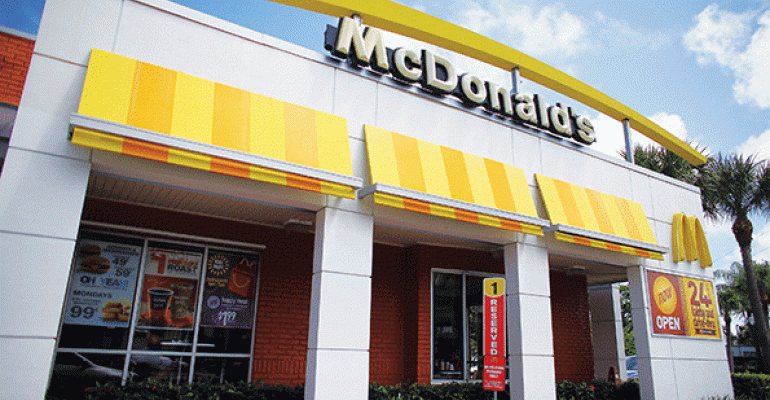 This post is part of the On the Margin blog.
This post is part of the On the Margin blog.
Large restaurant chains dominate the U.S. market and if you have any doubts, just look at the Nation’s Restaurant News Top 100 ranking.
This year, the 10 largest chains: McDonald’s, Starbucks, Subway, Burger King, Wendy’s, Taco Bell, Dunkin’ Donuts, Chick-fil-A, Pizza Hut and Domino’s all accounted for 46.3 percent of sales from the Top 100.
But here’s the thing: That number is shrinking.
Four years ago, the 10 largest chains accounted for 48.4 percent of Top 100 sales. And the percentage fell in each of the subsequent three years.
To be sure, it’s not like the 10 largest chains aren’t growing. Indeed, three chains in the latest year, Starbucks, Chick-fil-A and Domino’s, represented more than 27 percent of all the growth in the Top 100. All three have seen their systemwide sales increase by at least 35 percent over the past four years.
Yet substantial growth has been tougher to come by for many of the largest chains.
Consider:
 McDonald’s. Despite recent improvement, its domestic system sales are up less than 1 percent over the past four years. Much of that was due to a 1 percent decline in 2014. But even its growth years have been modest.
McDonald’s. Despite recent improvement, its domestic system sales are up less than 1 percent over the past four years. Much of that was due to a 1 percent decline in 2014. But even its growth years have been modest.
 Subway. The sandwich giant lost its place as the second largest restaurant chain in the country to Starbucks in NRN’s 2014 Top 100. But its system sales are down more than 5 percent over the past four years.
Subway. The sandwich giant lost its place as the second largest restaurant chain in the country to Starbucks in NRN’s 2014 Top 100. But its system sales are down more than 5 percent over the past four years.
 Pizza Hut. The country’s largest pizza chain is up less than 2 percent over the past four years and is in danger of losing its place in the coming years to hard-charging Domino’s.
Pizza Hut. The country’s largest pizza chain is up less than 2 percent over the past four years and is in danger of losing its place in the coming years to hard-charging Domino’s.
Overall, the 10 companies on our ranking from four years ago have had a median growth of just more than 7 percent since 2012. By comparison, sales in the Top 100 have grown by 15.6 percent.
To be sure, large chains don’t grow as fast as smaller chains — it’s difficult to generate 15 percent growth for a company with 2,000 locations and $5 billion in system sales, after all.
In addition, the shift isn't huge. The largest 10 chains still draw a massive percentage of customers, even if more are drinking lattes at Starbucks and consuming chicken sandwiches at Chick-fil-A than eating Subway footlongs or McDonald's Big Macs.
 In addition, big chains were quicker to recover from the recession, leading to strong sales in 2012 and helping them to an outsized proportion of sales. Still, even when analyzed over the course of the past six years, the share of sales from the largest chains is still trending downward.
In addition, big chains were quicker to recover from the recession, leading to strong sales in 2012 and helping them to an outsized proportion of sales. Still, even when analyzed over the course of the past six years, the share of sales from the largest chains is still trending downward.
These numbers reflect at least a modest shift of sales from the very largest chains to smaller and mid-sized concepts as consumers spread their spending around.
Some of those sales have gone to larger growth concepts like Chipotle (63 percent growth from 2012 through 2015) and Buffalo Wild Wings (45 percent). But they’re also going to chains like Jersey Mike’s, which has increased system sales by 67 percent since 2013, or Raising Cane’s, where sales have increased 51 percent.
The biggest chains, notably McDonald’s, Burger King and Wendy’s, might have recaptured some of that spending early this year amid heavy discount plans. But at least in the post-recessionary world, consumers want to try more, newer restaurants.
Contact Jonathan Maze at [email protected]
Follow him on Twitter at @jonathanmaze

